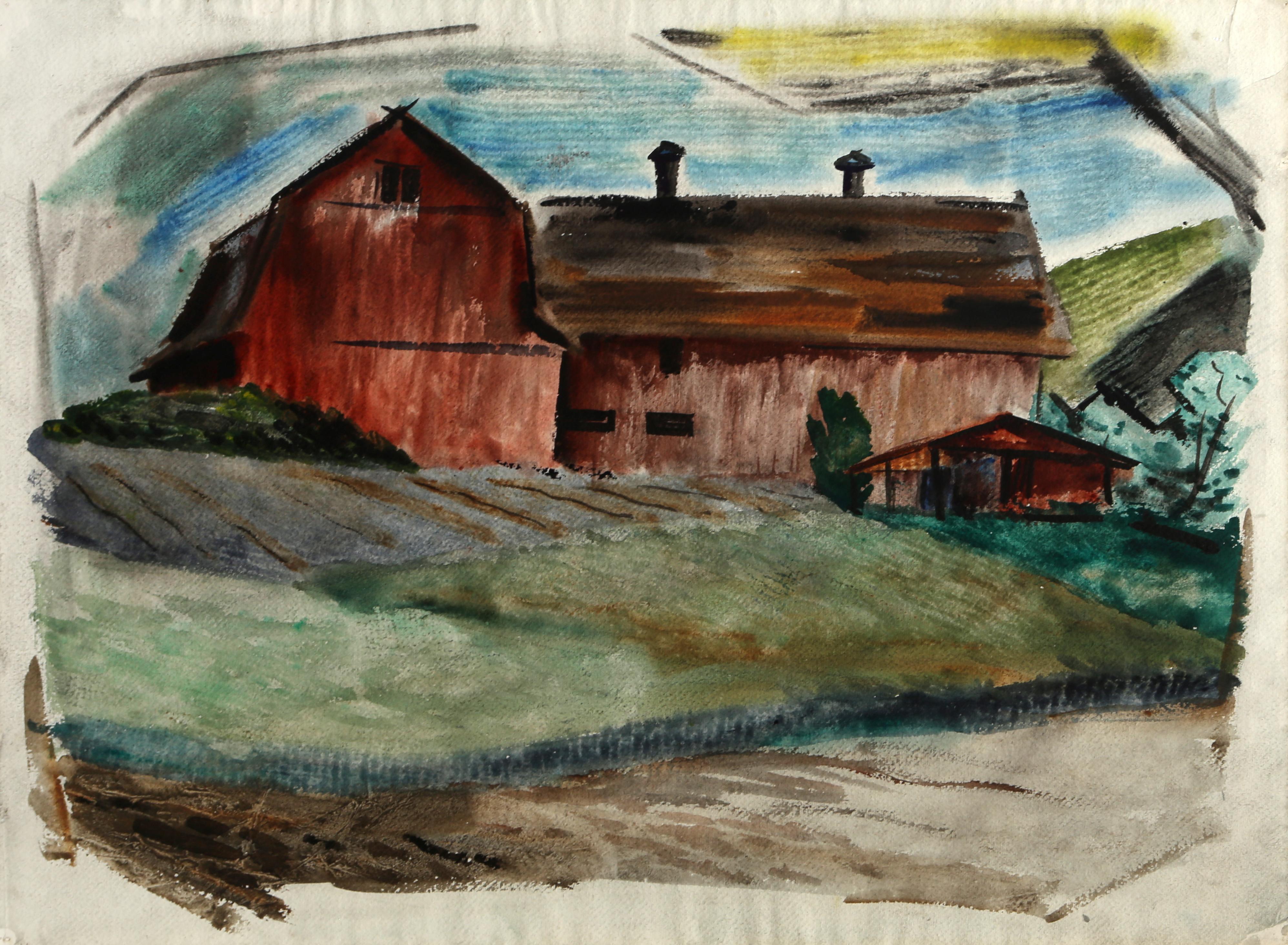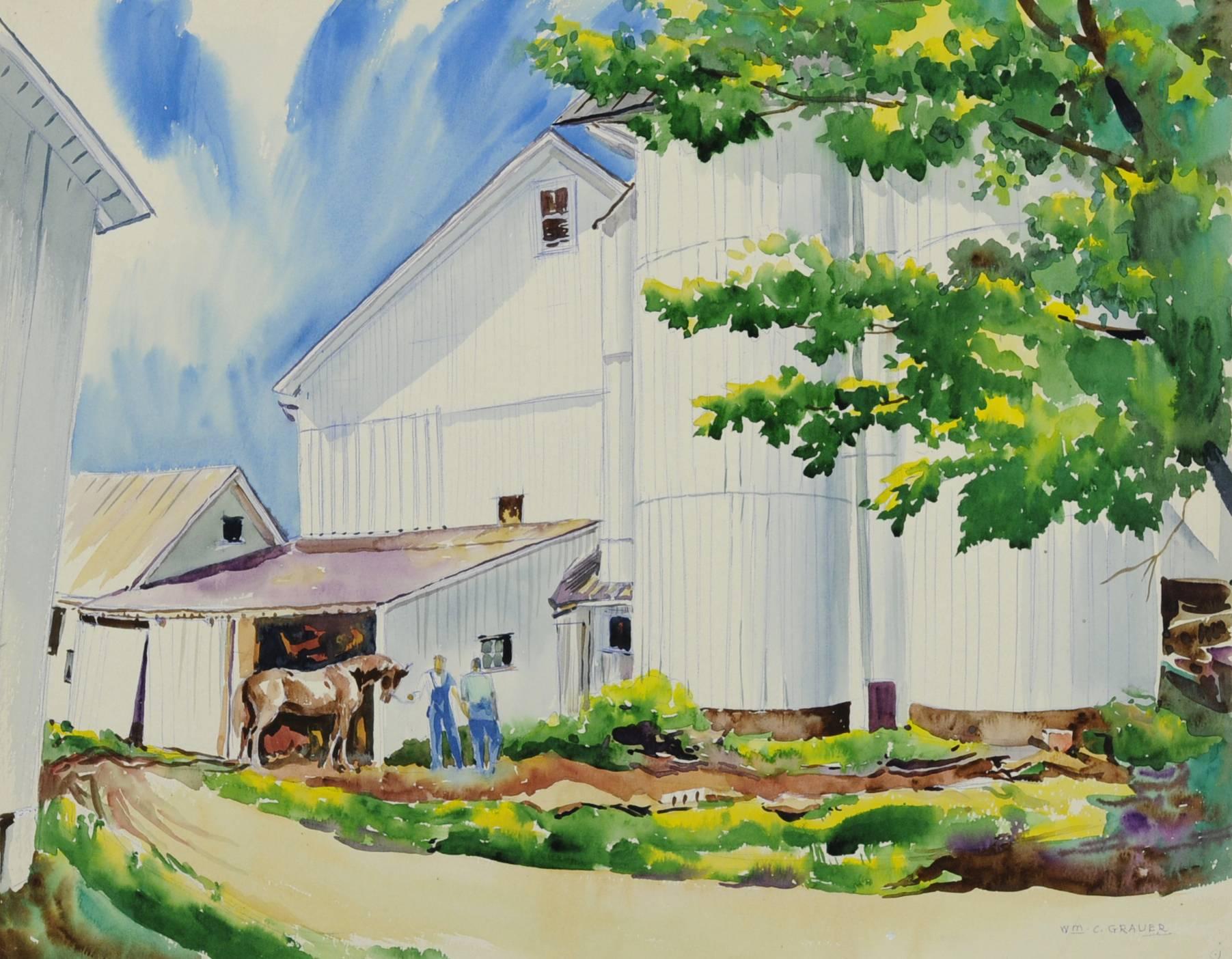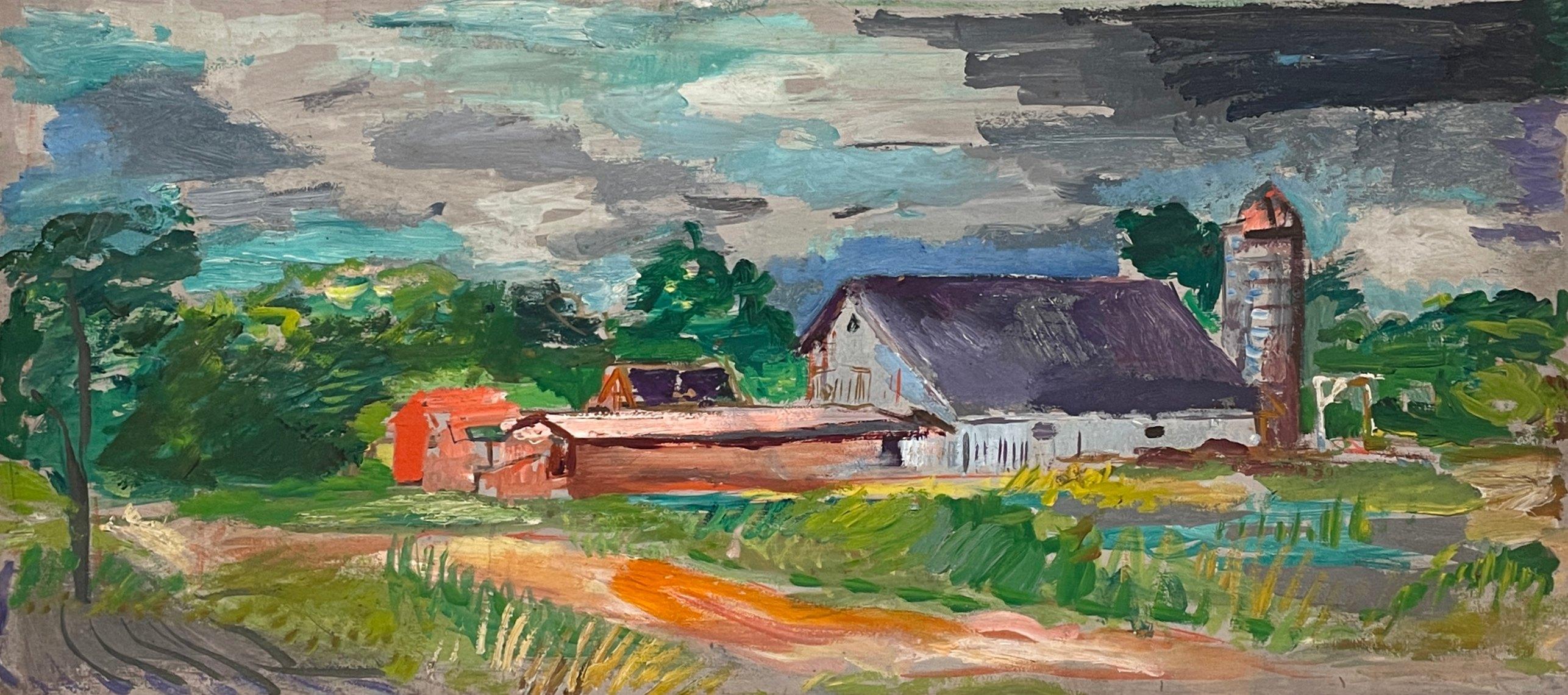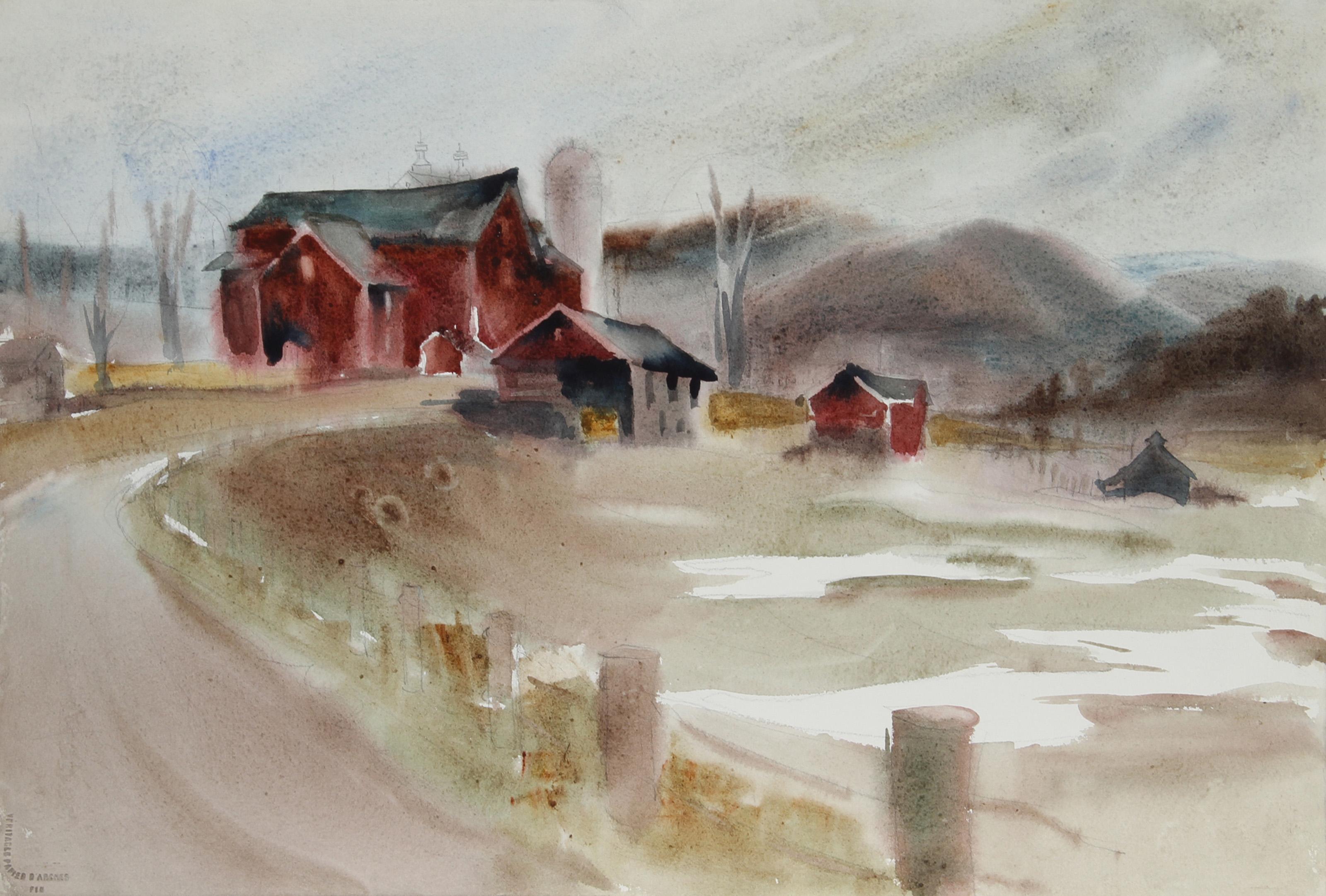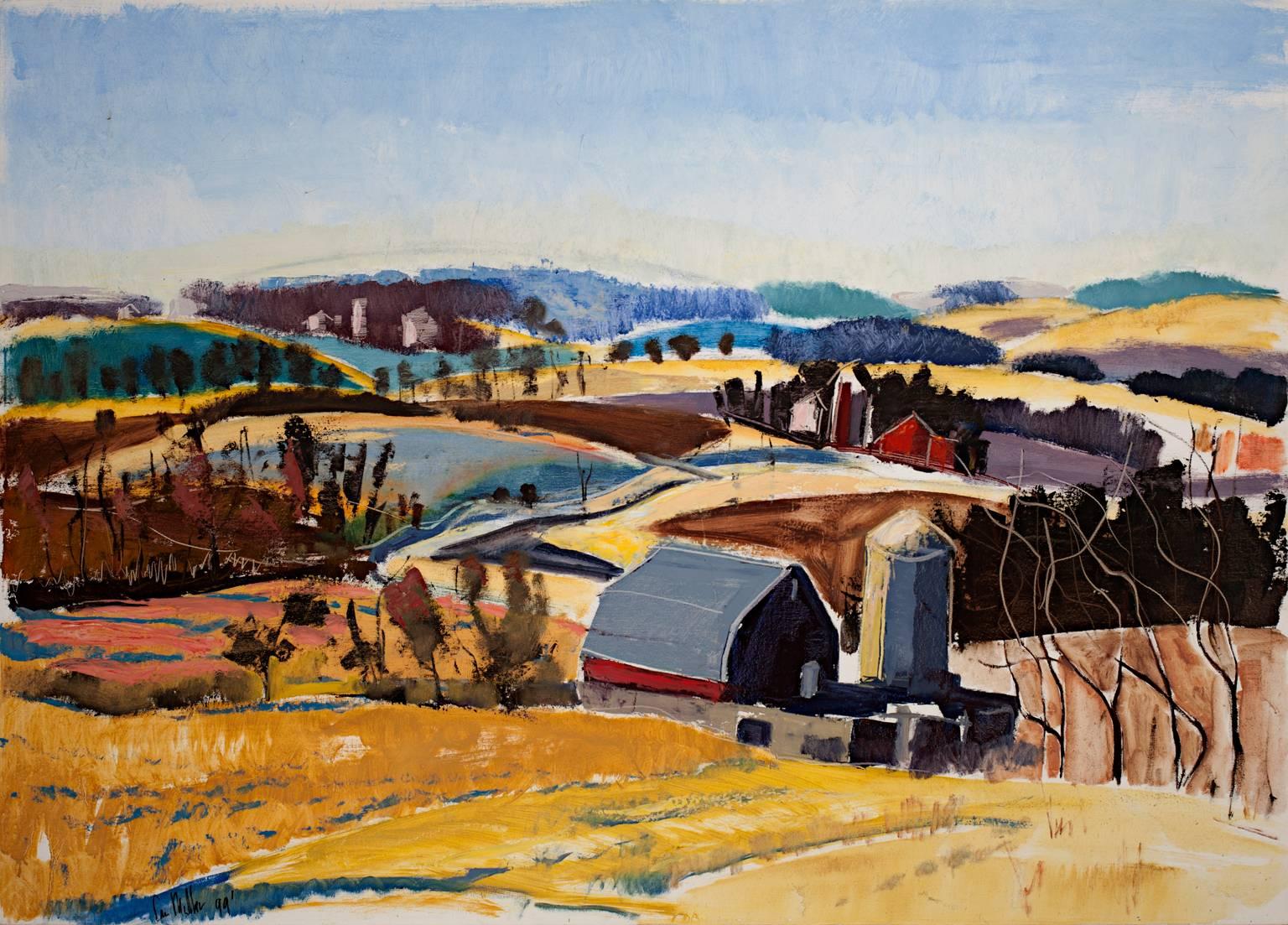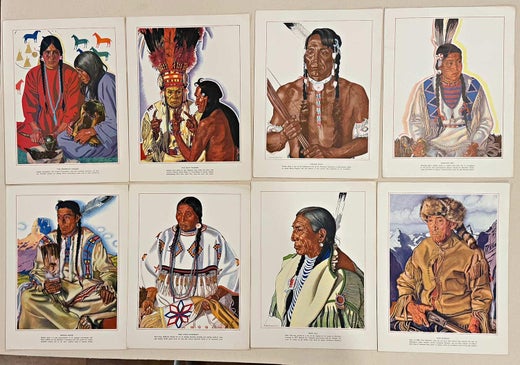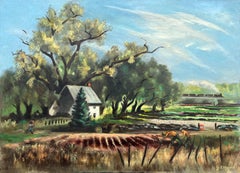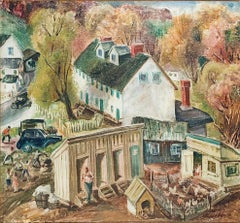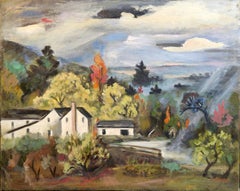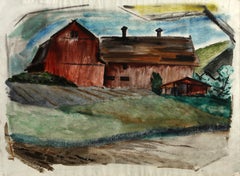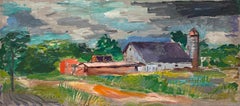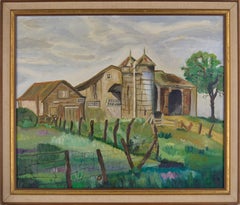Items Similar to "The Red Silo" Winold Reiss, Rural Regionalist Landscape, Sunny Day on Farm
Want more images or videos?
Request additional images or videos from the seller
1 of 8
Winold Reiss"The Red Silo" Winold Reiss, Rural Regionalist Landscape, Sunny Day on Farm
$12,000
£8,904.47
€10,372.48
CA$16,704.09
A$18,601.51
CHF 9,681.06
MX$229,354.34
NOK 123,295.66
SEK 115,885.97
DKK 77,391.59
Shipping
Retrieving quote...The 1stDibs Promise:
Authenticity Guarantee,
Money-Back Guarantee,
24-Hour Cancellation
About the Item
Winold Reiss
The Red Silo
Signed lower left
Watercolor on paper
20 x 29 inches
Winold Reiss (1886-1953) was an artist and designer who emigrated to the United States from Germany in 1913. Probably best known as a portraitist, Reiss was a pioneer of modernism and well known for his brilliant work in graphic and interior design. A compassionate man who greatly respected all people as human beings, he believed that his art could help break down racial prejudices. Like his father Fritz Reiss (1857-1915), who was also an artist and who was his son's first teacher, Winold Reiss was artistically moved by diverse cultures. The elder Reiss focused on folk life in Germany while Winold drew substantial inspiration from a range of cultures, particularly Native American, Mexican, and African-American.
As did many young aspiring artists, Winold Reiss studied with the esteemed painter and teacher Franz von Stuck at the Royal Academy of Fine Arts in Munich, which was at that time a center of the decorative and fine-arts movement. It is not known whether Reiss met E. Martin Hennings (1886-1956) and Walter Ufer (1876-1936), who were also studying at the Royal Academy about that time and who later became members of the Taos Art Society. All of these artists' works depict elements taught by von Stuck.
Romantic visions of the West had spread across France and Germany through the tales of artists who had already visited the western portion of the United States. The popular novels of German author Karl May (1842-1912), whose stories of the American west filled young minds with travel and adventure tales, dealt with noble Indians and cowboys and offered moral lessons. Young Reiss was an avid reader of May's books.
It was often due to the American railroad companies' commissions that artists were enabled to travel in the West, paint the native peoples, and enjoy the magnificent landscapes. Some of them, like Ernest Blumenschein (1874-1960), Ernest Hennings and Walter Ufer, as well as many European artists who had settled in the East, went to the Southwest where they were supported through the commissions of the Atchison, Topeka & Santa Fe Railway Company's advertising campaign. Winold Reiss, however, headed to the Northwest. He chose Montana as his destination after hearing about the Blackfeet Indians and Glacier Park from his friend H.V. Kaltenborn, editor of the Brooklyn Eagle, who had traveled there earlier. After his first trip to Montana in January of 1920, Reiss was able to return to Glacier Park many times in a long-lasting collaboration with the Great Northern Railway. His works graced the calendars, menus, playing cards, and souvenirs of the Great Northern Railway for thirty years, thus reaching a wide audience.
Reiss's works remain well known today, in part because of the railroad calendars and souvenirs produced from his portraits. However, his work—like that of other great artists and illustrators such as Norman Rockwell—survives and flourishes not just as a result of the Great Northern's printed matter but because he captured a very recognizable and uniquely American theme. Reiss also expressed the great feeling for color and design that his native friends favored. He rendered his subjects in a way that conveyed honor, beauty, and dignity upon them, free of racial prejudice. His own unique style can be viewed as a synthesis of bold, colorful graphic design, skillful drawing, and fine art.
- Creator:Winold Reiss (1886-1953, American)
- Dimensions:Height: 30.5 in (77.47 cm)Width: 39.5 in (100.33 cm)
- Medium:
- Movement & Style:
- Period:
- Condition:
- Gallery Location:New York, NY
- Reference Number:1stDibs: LU1841212878072
Winold Reiss
Winold Reiss was a German-American muralist and illustrator who is best remembered for his portraits of the Blackfoot Indian tribe. His work was so revered by the tribe that when he died, his ashes were spread across sacred burial grounds.
About the Seller
5.0
Platinum Seller
Premium sellers with a 4.7+ rating and 24-hour response times
Established in 2022
1stDibs seller since 2022
108 sales on 1stDibs
Typical response time: <1 hour
- ShippingRetrieving quote...Shipping from: New York, NY
- Return Policy
Authenticity Guarantee
In the unlikely event there’s an issue with an item’s authenticity, contact us within 1 year for a full refund. DetailsMoney-Back Guarantee
If your item is not as described, is damaged in transit, or does not arrive, contact us within 7 days for a full refund. Details24-Hour Cancellation
You have a 24-hour grace period in which to reconsider your purchase, with no questions asked.Vetted Professional Sellers
Our world-class sellers must adhere to strict standards for service and quality, maintaining the integrity of our listings.Price-Match Guarantee
If you find that a seller listed the same item for a lower price elsewhere, we’ll match it.Trusted Global Delivery
Our best-in-class carrier network provides specialized shipping options worldwide, including custom delivery.More From This Seller
View All"Glasco Landscape" Albert Heckman, circa 1940 New York Modernist Landscape
By Albert Heckman
Located in New York, NY
Albert Heckman
Glasco Landscape, circa 1940
Signed lower right
Oil on canvas
25 1/4 x 39 1/2 inches
Albert Heckman was born in Meadville, Western Pennsylvania, 1893. He went to New York City to try his hand at the art world in 1915 after graduating from high school and landing a job at the Meadville Post Office. In 1917, at the age of 24, Heckman enrolled part-time in Teachers' College, Columbia University's Fine Arts Department to begin his formal art education. He worked as a freelance ceramic and textile designer and occasionally as a lecturer at the Metropolitan Museum of Art. In the early 1920s, at the age of almost 30, he graduated with a Bachelor of Arts degree from Columbia Teachers College. He was especially impacted by his instructor at Columbia, Arthur Wesley Dow.
After graduating, he was hired by the Teachers' College as a Fine Arts instructor. He stayed with Columbia Teachers' College until 1929, when he left to attend the Leipzig Institute of Graphic Arts in Leipzig, Germany. Isami Doi (1903-1965), who was born in Hawaii, was arguably his most impressive student at Columbia. Doi is now regarded as one of the most prominent artists hailing from Hawaii. Heckman became an active member and officer of the Keramic Society and Design Guild of New York in the 1920s as part of his early commercial art career. The Society's mission was to share knowledge and showcase textile and ceramic design exhibits.
In 1922, Heckman married Florence Hardman, a concert violinist. Mrs. Heckman's concert schedule during the 1920s kept Albert and Florence Heckman apart for a significant portion of the time, but they spent what little time they had together designing and building their Woodstock, New York, summer house and grounds. A small house and an acre of surrounding land on Overlook Mountain, just behind the village of Woodstock, were purchased by Albert and Florence Heckman at the time of their marriage. Their Woodstock home, with its connections, friendships, and memories, became a central part of their lives over the years, even though they had an apartment in New York City.
Heckman's main artistic focus shifted to the house on Overlook Mountain and the nearby towns and villages, Kingston, Eddyville, and Glasco. After returning from the Leipzig Institute of Graphic Arts in 1930, Mr. Heckman joined Hunter College as an assistant professor of art. He worked there for almost thirty years, retiring in 1956. Throughout his tenure at Hunter, Mr. Heckman and his spouse spent the summers at their Woodstock residence and the winters in New York City. They were regular and well-known guests at the opera and art galleries in New York. Following his retirement in 1956, the Heckmans settled in Woodstock permanently, with occasional trips to Florida or Europe during the fall and winter. Mr. Heckman's close friends and artistic career were always connected to Woodstock or New York City. He joined the Woodstock art group early on and was greatly influenced by artists like Paul and Caroline Rohland, Emil Ganso, Yasuo Kuniyoshi, Andre Ruellan, and her husband, Jack...
Category
1940s American Modern Figurative Paintings
Materials
Canvas, Oil
"Truck Gardens" Georgina Klitgaard, Modernist Country Landscape With Train
By Georgina Klitgaard
Located in New York, NY
Georgina Klitgaard
Truck Gardens
Signed lower right
Oil on canvas
26 x 36 inches
Georgina Klitgaard’s art has sometimes gotten lost in the critical propensity to assign artists to ...
Category
Early 20th Century American Modern Figurative Paintings
Materials
Canvas, Oil
"Baseball in the Farmyard" Irwin Hoffman, New England Modernist Small Town Scene
Located in New York, NY
Irwin Hoffman
Baseball in the Farmyard
Signed lower right
Oil on canvas
24 1/2 x 29 1/2 inches
Irwin D. Hoffman was born on Chelsea Street, East Boston in 1901, one of four sons of...
Category
Early 20th Century American Modern Figurative Paintings
Materials
Canvas, Oil
"Newton’s Farm" Georgina Klitgaard, Modernist Hazy Autumn Landscape Painting
By Georgina Klitgaard
Located in New York, NY
Georgina Klitgaard
Newton’s Farm
Signed lower right
Oil on canvas
24 1/2 x 30 1/2 inches
Georgina Klitgaard’s art has sometimes gotten lost in the critical propensity to assign art...
Category
Early 20th Century American Modern Figurative Paintings
Materials
Canvas, Oil
"New England Landscape, " James Grabowski, View of Connecticut Hills in the Sun
Located in New York, NY
James L. Grabowski (American born 1944)
New England Landscape
Gouache on paper
27 1/2 x 39 1/2
Signed on the reverse
Has a plaque for Arches Paper Award
James Grabowski...
Category
Late 20th Century Contemporary Landscape Drawings and Watercolors
Materials
Paper, Gouache
"White Horse" Frederick Lester Sexton, Bucolic Barn, Farm Scene, White Horse
By Frederick Lester Sexton
Located in New York, NY
Frederick Lester Sexton
White Horse
Signed lower right
Oil on canvas
25 x 30 inches
Provenance
Part of a Collection received from the Lyme Art Association.
Frederick Lester Sexton received a lot of reviews and exhibitions in the 1920s, 1930s, and 1940s, when he was at the height of his career. Because it captured the personal view of many people's wish to ignore national issues and simply live their lives in their homes, his work was favorably welcomed. The rise of modernist styles like Abstract Expressionism, which started to take over the American art scene in the 1950s, also contributed to Sexton's fall in popularity. As collectors and regular spectators discover once more that realism is a valid component of American art because it speaks directly and clearly to the beauty they perceive in their surroundings, many artists, like Sexton, are experiencing a renaissance.
Cheshire, Connecticut, was the birthplace of Frederick Sexton in 1889. His father, J. Frederick Sexton, was the Rector of St. Peter's Church in Cheshire and a well-known Episcopal clergyman. The mother, Mary Louise Lester, was an amateur painter and came from a pretty well-known Hartford family. Frederick was killed in an open-hearth fire when he was eighteen months old. His right hand was badly burned and was never to be opened again. The father kept the family together after his mother passed away when he was nineteen.
Sexton's mother taught him art, and he went to public schools in New Haven. He received the prestigious Winchester Prize for a year of study in Spain while attending the Yale School of Fine Art, where he studied under Augustus Tack...
Category
1930s American Impressionist Figurative Paintings
Materials
Canvas, Oil
You May Also Like
Red Barn, Watercolor by Chris Ritter
Located in Long Island City, NY
This unique work is a watercolor by American artist Chris Ritter. The painting depicts a landscape of rolling green hills with a red barn centered in the ...
Category
1960s Landscape Drawings and Watercolors
Materials
Watercolor
untitled (The White Barn with Farmers and Horse)
By William Grauer
Located in Fairlawn, OH
untitled (The White Barn with Farmers and Horse)
Watercolor, c. 1950
Signed by the artist in ink lower right: Wm. C. Grauer
Numbered in pencil verso: 152
Provenance:
Estate of the Ar...
Category
1950s American Realist Landscape Drawings and Watercolors
Materials
Watercolor
A Picturesque ca. 1940s Farm Scene with a Barn & Silo by Artist Francis Chapin
By Francis Chapin
Located in Chicago, IL
A picturesque ca. 1940s, horizontal farm scene with a barn & silo, created in oil on Masonite, by Artist Francis Chapin. Painting likely depicts Wisconsin or Michigan. Painting is ...
Category
1940s American Modern Landscape Paintings
Materials
Masonite, Oil
Farm & Grain Silo Landscape
Located in Soquel, CA
Charming pastoral landscape of a farm with grain silos by unknown artist Kris (American, 20th Century). Signed "Kris" lower right. Displayed in a gilt-tone...
Category
Late 20th Century American Impressionist Landscape Paintings
Materials
Canvas, Oil
$440 Sale Price
20% Off
Big Red Barn, Impressionist Watercolor by Eve Nethercott
By Eve Nethercott
Located in Long Island City, NY
Eve Nethercott, American (1925 - 2015) - Big Red Barn (56), Year: circa 1961, Medium: Watercolor, Size: 15 in. x 22 in. (38.1 cm x 55.88 cm), Description: Eve Nethercott's hazy...
Category
1960s Impressionist Landscape Drawings and Watercolors
Materials
Watercolor
"The Red Barn - Wisconsin Landscape Series, " Oil on Canvas signed by Dan Muller
By Dan Muller
Located in Milwaukee, WI
"The Red Barn - Wisconsin Landscape Series" is an original oil painting on canvas by Dan Muller. The artists signed the painting in the lower left....
Category
1990s Contemporary Landscape Paintings
Materials
Canvas, Oil
More Ways To Browse
Rural America Painting
Vintage Sunnies
Regionalist Art
Montana Landscape Paintings
Norman West
Cowboy Drawing
Glacier Painting
Used Silo
French Noble Painting
Franz Stuck
Norman Rockwell Vintage Prints
Franz Von Stuck
Norman Rockwell Signed Prints
Native American Eagle Art
Artists Like Norman Rockwell
1960 Cowboy Art
Great Western Railway
Fritz Indian
